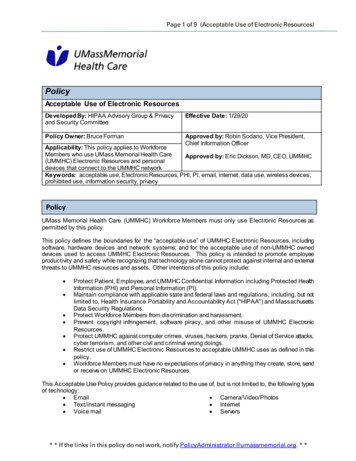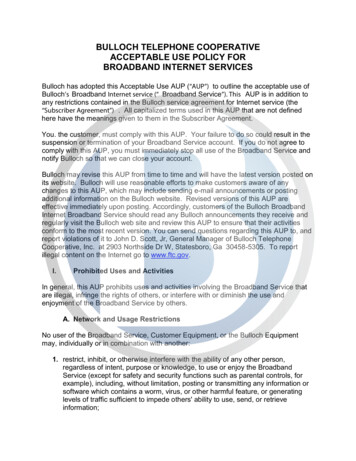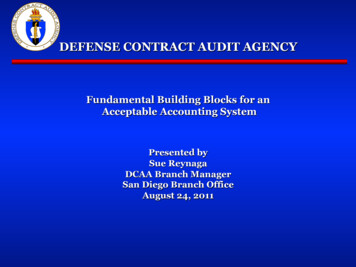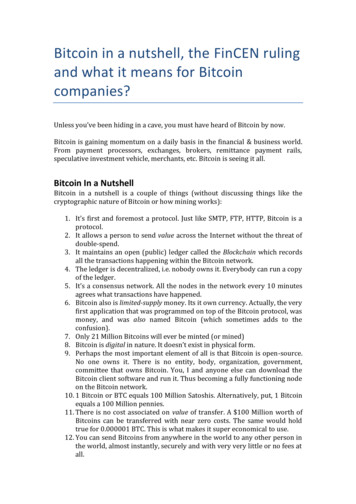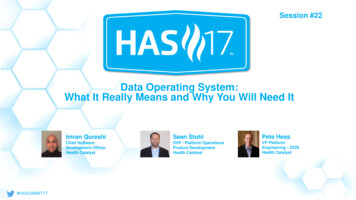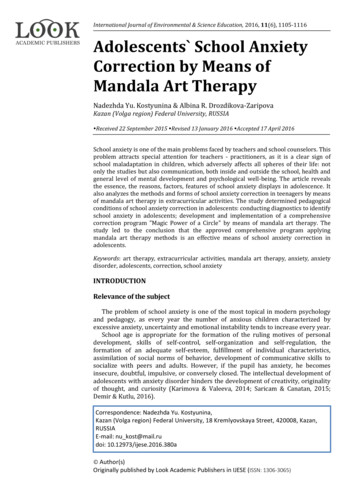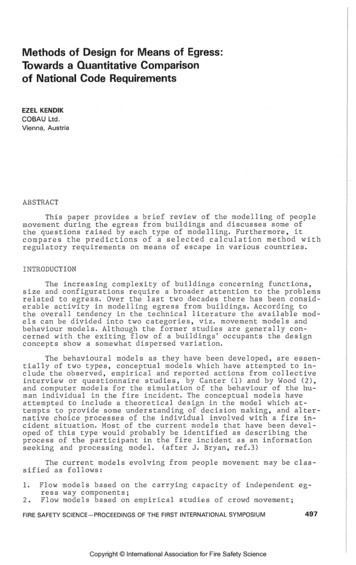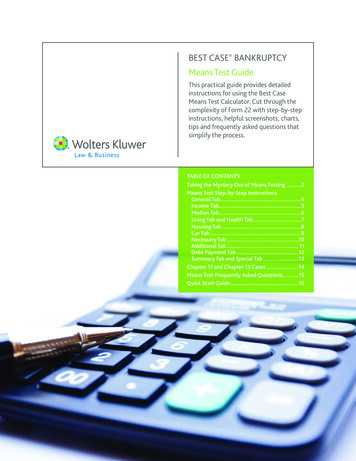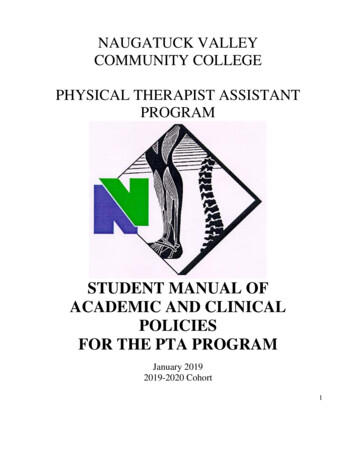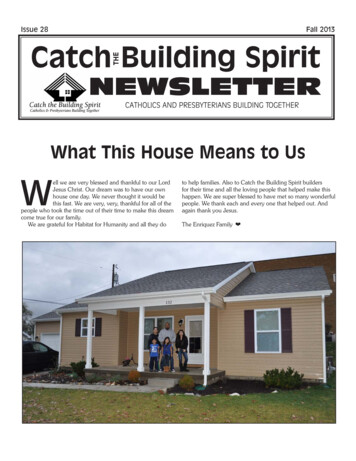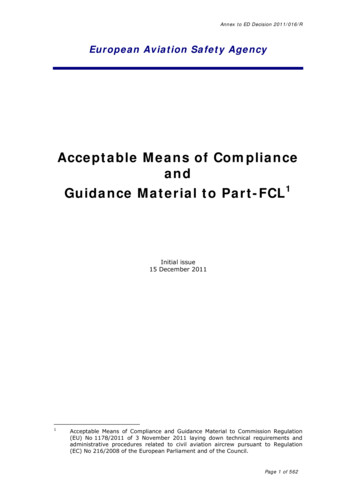
Transcription
Annex to ED Decision 2011/016/REuropean Aviation Safety AgencyAcceptable Means of ComplianceandGuidance Material to Part-FCL1Initial issue15 December 20111Acceptable Means of Compliance and Guidance Material to Commission Regulation(EU) No 1178/2011 of 3 November 2011 laying down technical requirements andadministrative procedures related to civil aviation aircrew pursuant to Regulation(EC) No 216/2008 of the European Parliament and of the Council.Page 1 of 562
Annex to ED Decision 2011/016/RTABLE OF CONTENTSSUBPART A — GENERAL REQUIREMENTS7GM1 FCL.005Scope7GM1 FCL.010Definitions8AMC1 FCL.015Application and issue of licences, ratings and certificates14AMC1 FCL.025Theoretical knowledge examinations for the issue of licences15AMC1 FCL.050Recording of flight time16AMC1 FCL.055Language proficiency26AMC2 FCL.055Language proficiency30AMC3 FCL.055Language proficiency35AMC1 FCL.060(b)(1)GM1 FCL.060(b)(1)AMC1 FCL.060(b)(5)Recent experienceRecent experienceRecent experience363738SUBPART B — LIGHT AIRCRAFT PILOT LICENCE — LAPL39AMC1 FCL.115; FCL.12039AMC1 FCL.120; FCL.12543AMC1 FCL.125LAPL — Skill test44AMC2 FCL.125LAPL — Skill test48AMC1 FCL.125; FCL.23551AMC2 FCL.125; FCL.23554AMC1 FCL.110.ALAPL(A) — Experience requirements and crediting58AMC2 FCL.110.ALAPL(A) — Experience requirements and crediting66GM1 FCL.135.A; FCL.135.H67AMC1 FCL.110.HLAPL(H) — Experience requirements and crediting68AMC2 FCL.110.HLAPL(H) — Experience requirements and crediting79AMC1 FCL.110.SLAPL(S) — Experience requirements and crediting80AMC1 FCL.110.S; FCL.210.S81AMC1 FCL.135.S; FCL.205.S(a)88Page 2 of 562
Annex to ED Decision 2011/016/RAMC1 FCL.110.BLAPL(B) — Experience requirements and crediting96AMC1 FCL.110.B; FCL.210.B97AMC1 FCL.130.B; FCL.220.B106AMC1 FCL.135.B; FCL.225.B107AMC2 FCL.135.B; FCL.225.B108AMC3 FCL.135.B; FCL.225.B112SUBPART C — PRIVATE PILOT LICENCE (PPL), SAILPLANE PILOT LICENCE (SPL)AND BALLOON PILOT LICENCE (BPL)115AMC1 FCL.210; FCL.215115AMC2 FCL.210; FCL.215160AMC3 FCL.210; FCL.215164AMC1 FCL.215; FCL.235165AMC1 FCL.235Skill test166AMC2 FCL.235Skill test171AMC3 FCL.235Skill test175AMC1 FCL.210.APPL(A) — Experience requirements and crediting178AMC1 FCL.210.HPPL(H) — Experience requirements and crediting187AMC1 FCL.210.AsPPL(As) — Experience requirements and crediting200AMC1 FCL.205.S(b)SPL — Privileges and conditions207AMC1 FCL.205.B(b)BPL — Privileges and conditions209AMC1 FCL.225.BBPL — Extension of privileges to another balloon class or group213SUBPART D — COMMERCIAL PILOT LICENCE — CPL214AMC1 FCL.310; FCL.515 (b); FCL.615 (b)214SUBPART F — AIRLINE TRANSPORT PILOT LICENCE — ATPL224AMC1 FCL.510.A (b)(1)224ATPL(A) — Prerequisites, experience and creditingAMC1 FCL.520.A; FCL.520.H225Page 3 of 562
Annex to ED Decision 2011/016/RSUBPART G — INSTRUMENT RATING — IR226AMC1 FCL.625(c)226IR — Validity, revalidation and renewalSUBPART H — CLASS AND TYPE RATINGS227GM1 FCL.700Circumstances in which class or type ratings are required227GM1 FCL.710Class and type ratings — variants229AMC1 FCL.725(a)Requirements for the issue of class and type ratings230AMC2 FCL.725(a)Requirements for the issue of class and type ratings245AMC1 FCL.740(b)(1)Validity and renewal of class and type ratings247AMC1 FCL.720.A(b)(2)(i) Experience requirements and prerequisites for the issue of classor type ratings — aeroplanes248AMC1 FCL.725.A(b) Theoretical knowledge and flight instruction for the issue of class andtype ratings — aeroplanes250AMC1 FCL.735.A; FCL.735.H; FCL.735.As253AMC1 FCL.740.H(a)(3)261Revalidation of type ratings — helicoptersGM1 FCL.720.PL Experience requirements and prerequisites for the issue of type ratings— powered-lift aircraft262SUBPART I — ADDITIONAL RATINGS263AMC1 FCL.800Aerobatic rating263AMC1 FCL.805Sailplane towing and banner towing rating265AMC1 FCL.810(b)Night rating267AMC1 FCL.815Mountain rating269AMC2 FCL.815Mountain rating272AMC1 FCL.820Flight test rating273SUBPART J — INSTRUCTORS281GM1 FCL.900281Instructor certificatesAMC1 FCL.920Instructor competencies and assessment282AMC1 FCL.925Additional requirements for instructors for the MPL284AMC2 FCL.925(d)(1)Additional requirements for instructors for the MPL286Page 4 of 562
Annex to ED Decision 2011/016/RGM1 FCL.925Additional requirements for instructors for the MPL287AMC1 FCL.935Assessment of competence288AMC2 FCL.935Assessment of competence289AMC3 FCL.935Assessment of competence290AMC4 FCL.935Assessment of competence293AMC5 FCL.935Assessment of competence294AMC1 FCL.930.FIFI — Training course300AMC2 FCL.930.FIFI — Training course356AMC1 FCL.940.FI(a)(2)GM1 FCL.940.FI(a)(2)FI — Revalidation and renewal391FI — Revalidation and renewal392AMC1 FCL.930.TRITRI — Training course399AMC2 FCL.930.TRITRI — training course409AMC1 FCL.930.CRICRI — Training course414AMC1 FCL.940.CRICRI — Revalidation and renewal441AMC1 FCL.930.IRIIRI — Training course442AMC1 FCL.930.MCCIMCCI — Training course478SUBPART K — EXAMINERS481GM1 FCL.1000481Examiner certificatesGM1 FCL.1005(b)Limitation of privileges in case of vested interests482AMC1 FCL.1010Prerequisites for examiners483AMC1 FCL.1015Examiner standardisation484AMC2 FCL.1015Examiner standardisation486GM1 FCL.1015AMC1 FCL.1020Examiner standardisation490Examiners assessment of competence491AMC1 FCL.1020; FCL.1025494AMC1 FCL.1025495Validity, revalidation and renewal of examiner certificatesAMC1 FCL.1030 (b)(3)competenceConduct of skill tests, proficiency checks and assessments of496Page 5 of 562
Annex to ED Decision 2011/016/RAPPENDICESAMC1 to Appendix 3497Training courses for the issue of a CPL and an ATPL497GM1 to Appendix 3; Appendix 6; FCL.735.H524GM1 to Appendix 5527Integrated MPL training courseAMC1 to Appendix 6Modular training course for the IR549AMC2 to Appendix 6Modular training course for the IR550AMC3 to Appendix 6Modular training course for the IR554GM1 to Appendix 7AMC1 to Appendix 7IR skill testIR skill test558559AMC1 to Appendix 9 Training, skill test and proficiency check for MPL, ATPL, type andclass ratings, and proficiency check for IRs560AMC2 to Appendix 9 Training, skill test and proficiency check for MPL, ATPL, type andclass ratings, and proficiency check for IRs562Page 6 of 562
Annex to ED Decision 2011/016/RSUBPART A — GENERAL REQUIREMENTSGM1 FCL.005ScopeINTERPRETATIVE MATERIAL(a)Whenever licences, ratings, approvals or certificates are mentioned inPart-FCL, these are meant to be valid licences, ratings, approvals orcertificates issued in accordance with Part-FCL. In all other cases, thesedocuments are specified.(b)Whenever a reference is made to Member States to mutual recognition oflicences, ratings, approvals or certificates, this means a European UnionMember State and states associated to the Agency in accordance withArticle 55 of the Regulation (EC) No 216/2008 of the European Parliamentand of the Council of 20 February 2008.(c)Whenever ‘or’ is used as an inclusive ‘or’, it should be understood in thesense of ‘and/or’.Page 7 of 562
Annex to ED Decision 2011/016/RGM1 FCL.010DefinitionsABBREVIATIONSThe following abbreviations apply to the Acceptable Means of Compliance andGuidance Material to Part-FCL:AAeroplaneACAlternating CurrentACASAirborne Collision Avoidance SystemADFAutomatic Direction FindingADSAeronautical Design StandardAFCSAutomatic Flight Control SystemAFMAircraft Flight ManualAGLAbove Ground LevelAICAeronautical Information CircularAIPAeronautical Information PublicationAIRACAeronautical Information regulation and controlAISAeronautical Information ServicesAMCAcceptable Means of ComplianceAeMCAero-medical CentreAMEAero-medical ExaminerAOMAircraft Operating ManualAPUAuxiliary Power UnitAsAirshipATCAir Traffic ControlATISAutomatic Terminal Information ServiceATOApproved Training OrganisationATPAirline Transport PilotATPLAirline Transport Pilot LicenceATSAir Traffic ServiceAUMAll Up MassBBalloonBCARBritish Civil Airworthiness RequirementBEMBasic Empty MassBITDBasic Instrument Training DeviceBPLBalloon Pilot LicencePage 8 of 562
Annex to ED Decision 2011/016/RCASCalibrated Air SpeedCATClear Air TurbulenceCDICourse Deviation IndicatorCFIChief Flying InstructorCGCentre of GravityCGIChief Ground InstructorCPCo-pilotCPLCommercial Pilot LicenceCREClass Rating ExaminerCRIClass Rating InstructorCRMCrew Resource ManagementCSCertification SpecificationCQBCentral Question BankDCDirect CurrentDFDirection FindingDMEDistance Measuring EquipmentDPATODefined Point After Take-offDPBLDefined Point Before LandingDRDead Reckoning navigationEFISElectronic Flight Instrument SystemEOLEngine Off LandingsERPMEngine Revolution Per MinuteETAEstimated Time of ArrivalETOPSExtended-range Twin-engine Operation Performance StandardFAFFinal Approach FixFARFederal Aviation RegulationsFCLFlight Crew LicensingFEFlight ExaminerF/EFlight EngineerFEMFlight Examiner ManualFFSFull Flight SimulatorFIFlight InstructorFIEFlight Instructor ExaminerFISFlight Information ServiceFMCFlight Management ComputerPage 9 of 562
Annex to ED Decision 2011/016/RFMSFlight Management SystemFNPTFlight and Navigation Procedures TrainerFSFlight SimulatorFSTDFlight Simulation Training DeviceftfeetFTDFlight Training DeviceGGravity forcesGLONASS Global Orbiting Navigation Satellite SystemGMGuidance MaterialGNSSGlobal Navigation Satellite SystemsGPSGlobal Positioning SystemHHelicopterHFHigh FrequencyHOFCSHigh Order Flight Control SystemHPAHigh Performance AeroplanehrsHoursHUMSHealth and Usage Monitoring SystemHTHead of TrainingIASIndicated Air SpeedICAOInternational Civil Aviation OrganisationIGEIn Ground EffectIFRInstrument Flight RulesILSInstrument Landing SystemIMCInstrument Meteorological ConditionsIRInstrument RatingIREInstrument Rating ExaminerIRIInstrument Rating InstructorISAInternational Standard AtmosphereJARJoint Aviation RequirementskgKilogramLAPLLight Aircraft Pilot LicenceLDPLanding Decision PointLMTLocal Mean TimePage 10 of 562
Annex to ED Decision 2011/016/RLOLearning ObjectivesLOFTLine Orientated Flight TrainingmMeterMCCMulti-Crew CooperationMCCIMulti-Crew Cooperation InstructorMEMulti-engineMELMinimum Equipment ListMEPMulti-engine PistonMETMulti-engine TurbopropMETARMeteorological Aerodrome ReportMIMountain Rating InstructorMPMulti-pilotMPAMulti-pilot AeroplaneMPLMulti-crew Pilot LicenceMPHMulti-pilot HelicopterMTOMMaximum Take-off MassNDBNon-directional BeaconNMNautical MilesNOTAMNotice To AirmenNOTARNo Tail RotorOATOutside Air TemperatureOBSOmni Bearing SelectorOEIOne Engine InoperativeOGEOut of Ground EffectOMLOperational Multi-pilot LimitationOSLOperational Safety Pilot LimitationOTDOther Training DevicesPAPIPrecision Approach Path IndicatorPFPilot FlyingPICPilot-In-CommandPICUSPilot-In-Command Under SupervisionPLPowered-liftPNFPilot Not FlyingPPLPrivate Pilot LicencePage 11 of 562
Annex to ED Decision 2011/016/RQDMMagnetic headingQFEAtmospheric pressure at aerodrome elevationQNHAltimeter sub-scale setting to obtain elevation when on the groundRNAVRadio NavigationRPMRevolution Per MinuteRRPMRotor Revolution Per MinuteR/TRadiotelephonySSailplaneSATCOM Satellite communicationSESingle-engineSEPSingle-engine PistonSETSingle-engine TurbopropSFESynthetic Flight ExaminerSFISynthetic Flight InstructorSIDStandard Instrument DepartureSIGMETSignificant Meteorological WeatherSLPCSingle Lever Power ControlSOPStandard Operating ProcedureSPSingle-pilotSPASingle-pilot AeroplaneSPHSingle-pilot HelicopterSPICStudent PICSPLSailplane Pilot LicenceSSRSecondary Surveillance RadarSTISynthetic Training InstructorTAF(Terminal Area Forecasts) Aerodrome ForecastTASTrue Air SpeedTAWSTerrain Awareness Warning SystemTDPTake-off Decision PointTEMThreat and Error ManagementTMGTouring Motor GliderTORATake-off Run AvailableTODATake-off Distance AvailableTRType RatingTREType Rating ExaminerTRIType Rating InstructorPage 12 of 562
Annex to ED Decision 2011/016/RUTCCoordinated Universal TimeVVelocityVASIVisual Approach Slope IndicatorVFRVisual Flight RulesVHFVery High FrequencyVMCVisual Meteorological ConditionsVORVHF Omni-directional Radio RangeZFTTZero Flight Time TrainingZFMZero Fuel MassPage 13 of 562
Annex to ED Decision 2011/016/RAMC1 FCL.015Application and issue of licences, ratings and certificatesAPPLICATION AND REPORT FORMSCommon application and report forms can be found:(a)For skill tests, proficiency checks for issue, revalidation or renewal of LAPL,BPL, SPL, PPL, CPL and IR in AMC1 to Appendix 7.(b)For training, skill tests or proficiency checks for ATPL, MPL and class andtype ratings, in AMC1 to Appendix 9.(c)For assessments of competence for instructors, in AMC5 FCL.935.Page 14 of 562
Annex to ED Decision 2011/016/RAMC1 FCL.025Theoretical knowledge examinations for the issue oflicencesTERMINOLOGYThe meaning of the following terms used in FCL.025 should be as follows:(a)‘Entire set of examinations’: an examination in all subjects required by thelicence level.(b)‘Examination’: the demonstration of knowledge in one or more examinationpapers.(c)‘Examination paper’: a set of questions to be answered by a candidate forexamination.(d)‘Attempt’: a try to pass a specific paper.(e)‘Sitting’: a period of time established by the competent authority withinwhich a candidate can take an examination. This period should not exceed10 consecutive days. Only one attempt at each examination paper is allowedin one sitting.Page 15 of 562
Annex to ED Decision 2011/016/RAMC1 FCL.050Recording of flight timeGENERAL(a)The record of the flights flown should contain at least the followinginformation:(1)personal details: name(s) and address of the pilot;(2)for each flight:(i)name(s) of PIC;(ii) date of flight;(iii) place and time of departure and arrival;(iv) type, including make, model and variant, and registrationof the aircraft;(v) indication if the aircraft is SE or ME, if applicable;(vi) total time of flight;(vii) accumulated total time of flight.(3)(b)for each FSTD session, if applicable:(i)type and qualification number of the training device;(ii)FSTD instruction;(iii)date;(iv)total time of session;(v)accumulated total time.(4)details on pilot function, namely PIC, including solo, SPIC andPICUS time, co-pilot, dual, FI or FE;(5)Operational conditions, namely if the operation takes place atnight, or is conducted under instrument flight rules.Logging of time:(1)PIC flight time:(i)the holder of a licence may log as PIC time all of theflight time during which he or she is the PIC;(ii)the applicant for or the holder of a pilot licence may logas PIC time all solo flight time, flight time as SPIC andflight time under supervision provided that such SPICtime and flight time under supervision are countersignedby the instructor;(iii)the holder of an instructor certificate may log as PIC allflight time during which he or she acts as an instructor inan aircraft;(iv)the holder of an examiner’s certificate may log as PIC allflight time during which he or she occupies a pilot’s seatand acts as an examiner in an aircraft;(v)a co-pilot acting as PICUS on an aircraft on which morethan one pilot is required under the type certification ofthe aircraft or as required by operational requirementsPage 16 of 562
Annex to ED Decision 2011/016/Rprovided that such PICUS time is countersigned by thePIC;(vi)(c)if the holder of a licence carries out a number of flightsupon the same day returning on each occasion to thesame place of departure and the interval betweensuccessive flights does not exceed 30 minutes, suchseries of flights may be recorded as a single entry.(2)co-pilot flight time: the holder of a pilot licence occupying apilot seat as co-pilot may log all flight time as co-pilot flighttime on an aircraft on which more than one pilot is requiredunder the type certification of the aircraft, or the regulationsunder which the flight is conducted;(3)cruise relief co-pilot flight time: a cruise relief co-pilot may logall flight time as co-pilot when occupying a pilot’s seat;(4)instruction time: a summary of all time logged by an applicantfor a licence or rating as flight instruction, instrument flightinstruction, instrument ground time, etc., may be logged ifcertified by the appropriately rated or authorised instructorfrom whom it was received;(5)PICUS flight time: provided that the method of supervision isacceptable to the competent authority, a co-pilot may log asPIC flight time flown as PICUS when all the duties andfunctions of PIC on that flight were carried out in such a waythat the intervention of the PIC in the interest of safety wasnot required.Format of the record:(1)details of flights flown under commercial air transport may berecorded in a computerised format maintained by theoperator. In this case an operator should make the records ofall flights operated by the pilot, including differences andfamiliarisation training, available upon request to the flightcrew member concerned;(2)for other types of flight, the pilot should record the details ofthe flights flown in the following logbook format. For sailplanesand balloons, a suitable format should be used that containsthe relevant items mentioned in (a) and additional informationspecific to the type of operation.Page 17 of 562
Annex to ED Decision 2011/016/RPILOT LOGBOOKHolder’s name(s)Holder’s licence numberPage 18 of 562
Annex to ED Decision 2011/016/RHOLDER’S ADDRESS:[space for address change][space for address change][space for address change][space for address change][space for address change]Page 19 of 562
Annex to ED Decision FTSINGLEPILOTTIMEPLACEPLACETIMETIMEMAKE, MODEL,VARIANTREGISTRATIONTOTAL THISPAGETOTAL FROMPREVIOUSPAGESTOTAL TIMEPage 20 of 562SEMEMULTIPILOTTIME678TOTALTIME OFNAME(S) PICLANDINGSFLIGHTDAYNIGHT
Annex to ED Decision 2011/016/R9101112OPERATIONAL CONDITIONTIMEPILOT FUNCTION TIMEFSTD SESSIONREMARKSAND ATE(dd/mm/yy)TOTAL TIME OFSESSIONI certify that the entriesin this log are true.PILOT’S SIGNATUREPage 21 of 562
Annex to ED Decision 2011/016/RINSTRUCTIONS FOR USE(d)FCL.050 requires holders of a pilot licence to record details of allflights flown. This logbook enables pilot licence holders to recordflying experience in a manner which will facilitate this process whileproviding a permanent record of the licence holders flying. Pilotswho fly regularly aeroplanes and helicopters or other aircraftcategories are recommended to maintain separate logbooks for eachaircraft category.(e)Flight crew logbook entries should be made as soon as practicableafter any flight undertaken. All entries in the logbook should bemade in ink or indelible pencil.(f)The particulars of every flight in the course of which the holder of aflight crew licence acts as a member of the operating crew of anaircraft are to be recorded in the appropriate columns using one linefor each flight, provided that if an aircraft carries out a number offlights upon the same day returning on each occasion to the sameplace of departure and the interval between successive flights doesnot exceed 30 minutes, such series of flights may be recorded as asingle entry.(g)Flight time is recorded:(1)for aeroplanes, touring motor gliders and powered-lift aircraft,from the moment an aircraft first moves to taking off until themoment it finally comes to rest at the end of the flight;(2)for helicopters, from the moment a helicopter’s rotor bladesstart turning until the moment the helicopter finally comes torest at the end of the flight, and the rotor blades are stopped;(3)for airships, from the moment an airship is released from themast to taking off until the moment the airship finally comesto rest at the end of the flight, and is secured on the mast;(h)When an aircraft carries two or more pilots as members of theoperating crew, one of them shall, before the flight commences, bedesignated by the operator as the aircraft PIC, according tooperational requirements, who may delegate the conduct of theflight to another suitably qualified pilot. All flying carried out as PICis entered in the logbook as ‘PIC’. A pilot flying as ‘PICUS’ or ‘SPIC’enters flying time as ‘PIC’ but all such entries are to be certified bythe PIC or FI in the ‘Remarks’ column of the logbook.(i)Notes on recording of flight time:(1)column 1: enter the date (dd/mm/yy) on which the flightcommences;(2)column 2 or 3: enter the place of departure and destinationeither in full or the internationally recognised three or fourletter designator. All times should be in UTC;(3)column 5: indicate whether the operation was SP or MP, andfor SP operation whether SE or ME;Page 22 of 562
Annex to ED Decision 8TOTALTIME OFNAME(S)PICLANDINGSMEFLIGHT 215SELF120SELF2940NAME(S)PIC1 Page 23 of 562940DAYNIGHT1
Annex to ED Decision 2011/016/R(4)column 6: total time of flight may be entered in hours andminutes or decimal notation as desired;(5)column 7: enter the name(s) of PIC or SELF as appropriate;(6)column 8: indicate the number of landings as pilot flying byday or night;(7)column 9: enter flight time undertaken at night or underinstrument flight rules if applicable;(8)column 10: pilot function time:(i)enter flight time as PIC, SPIC and PICUS as PIC;(ii) all time recorded as SPIC or PICUS is countersigned bythe aircraft PIC/FI in the ‘remarks’ (column 12);(iii) instructor time should be recorded as appropriate andalso entered as PIC.(9)column 11: FSTD:(i)for any FSTD enter the type of aircraft and qualificationnumber of the device. For other flight training devicesenter either FNPT I or FNPT II as appropriate;(ii) total time of session includes all exercises carried out inthe device, including pre- and after-flight checks;(iii) enter the type of exercise performed in the ‘remarks’(column 12), for example operator proficiency check,revalidation.(10) column 12: the ‘remarks’ column may be used to recorddetails of the flight at the holder’s discretion. The followingentries, however, should always be made:(i)instrument flight time undertaken as part of the trainingfor a licence or rating;(ii) details of all skill tests and proficiency checks;(iii) signature of PIC if the pilot is recording flight time asSPIC or PICUS;(iv) signature of instructor if flight is part of an SEP or TMGclass rating revalidation.(j)When each page is completed, accumulated flight time or hoursshould be entered in the appropriate columns and certified by thepilot in the ‘remarks’ column.Page 24 of 562
Annex to ED Decision 2011/016/RExample:9101112OPERATIONALCONDITION TIMEPILOT FUNCTION TIMEFSTD SESSIONREMARKSNIGHTPICIFR211520AND m/yy)109409TOTALTIME OFSESSION20Night rating ion proficiency checkPIC(US): signature of NAME(S) PICPage 25 of 562
Annex to ED Decision 2011/016/RAMC1 FCL.055Language proficiencyGENERAL(a)The language proficiency assessment should be designed to reflect a rangeof tasks undertaken by pilots but with specific focus on language rather thanoperational procedures.(b)The assessment should determine the applicant’s ability to:(1)communicate effectively using standard R/T phraseology;(2)deliver and understand messages in plain language in both usual andunusual situations that necessitate departure from standard R/Tphraseology.Note: refer to the ‘Manual on the Implementation of ICAO LanguageProficiency Requirements’ (ICAO Doc 9835), Appendix A Part III andAppendix B for further guidance.ASSESSMENT(c)The assessment may be subdivided into three elements, as follows:(1)listening: assessment of comprehension;(2)speaking: n,fluency,structureand(d)The three elements mentioned above may be combined and they can becovered by using a wide variety of means or technologies.(e)Where appropriate, some or all of these elements may be achieved throughthe use of the R/T testing arrangements.(f)When the elements of the testing are assessed separately, the finalassessment should be consolidated in the language proficiency endorsementissued by the competent authority.(g)The assessment may be conducted during one of the several existingchecking or training activities, such as licence issue or rating issue andrevalidation, line training, operator line checks or proficiency checks.(h)The competent authority may use its own resources in developing orconducting the language proficiency assessment, or may delegate this taskto language assessment bodies.(i)The competentapplicants.(j)The holder of a licence should receive a statement containing the level andvalidity of the language endorsements.(k)Where the assessment method for the English language established by thecompetent authority is equivalent to that established for the assessment ofuse of the English language in accordance with AMC2 FCL.055, the sameassessment may be used for both forPage 26 of 562
Annex to ED Decision 2011/016/RBASIC ASSESSMENT REQUIREMENTS(l)The aim of the assessment is to determine the ability of an applicant for apilot licence or a licence holder to speak and understand the language usedfor R/T communications.(1)(2)The assessment should determine the ability of the applicant to useboth:(i)standard R/T phraseology;(ii)plain language, in situations when standardised phraseologycannot serve an intended transmission.The assessment should include:(i)voice-only or face-to-face situations;(ii)common, concrete and work-related topics for pilots.(3)The applicants should demonstrate their linguistic ability in dealing withan unexpected turn of events, and in solving apparentmisunderstandings.(4)The assessment should determine the applicant’s speaking andlistening abilities. Indirect assessments, of grammatical knowledge,reading and writing, are not appropriate.(5)The assessment should determine the language skills of the applicantin the following areas:(i)(ii)pronunciation:(A)the extent to which the pronunciation, stress, rhythm andintonation are influenced by the applicant’s first language ornational variations;(B)how much they interfere with ease of understanding.structure:(A)the ability of the applicant to use both basic and complexgrammatical structures;(B)the extent to which the applicant’s errors interfere with themeaning.(iii) vocabulary:(A)the range and accuracy of the vocabulary used;(B)the ability of the applicant to paraphrase successfully whenlacking vocabulary.(iv) fluency:(v)(A)tempo;(B)hesitancy;(C)rehearsed versus spontaneous speech;(D)use of discourse markers and connectors.comprehension:(A)on common, concrete and work-related topics;(B)when confronted with a linguistic or situational complicationor an unexpected turn of events.Page 27 of 562
Annex to ED Decision 2011/016/RNote: the accent or variety of accents used in the test materialshould be sufficiently intelligible for an international community ofusers.(vi) he ability to initiate and maintain exchanges:(C)(immediate,appropriate,(a)on common, concrete and work-related topics;(b)when dealing with an unexpected turn of events.andthe ability to deal with apparent misunderstandings bychecking, confirming or clarifying.Note: the assessment of the language skills in the areasmentioned above is conducted using the rating scale in AMC2FCL.055.(6)When the assessment is not conducted in a face-to-face situation, itshould use appropriate technologies for the assessment of theapplicant’s abilities in listening and speaking, and for ntrollercommunication).ASSESSORS(m) It is essential that the persons responsible for language proficiencyassessment (‘assessors’) are suitably trained and qualified. They should beeither aviation specialists (for example current or former flight crewmembers or air traffic controllers), or language specialists with additionalaviation-related training. An alternative approach would be to form anassessment team consisting of an operational expert and a language expert.(1)The assessors should be trained on the specific requirements of theassessment.(2)The assessors should not test applicants to whom they have givenlanguage training.CRITERIA FOR THE ACCEPTABILITY OF LANGUAGE ASSESSMENT BODIES(n)To ensure an impartial assessment process, the language assessmentshould be independent of the language training.(1)(2)To be accepted, the language assessment bodies should demonstrate:(i)appropriate management and staffing;(ii)quality system established and maintained to ensure compliancewith, and adequacy of, assessment requirements, standards andprocedures.The quality system established by a language assessment body shouldaddress the following:(i)management;(ii)policy and strategy;(iii) processes;Page 28 of 562
Annex to ED Decision 2011/016/R(iv) the relevant provisions of ICAO or Part-FCL, standards andassessment procedures;(v)organisational structure;(vi) responsibilityforthedevelopment,management of the quality system;establishmentand(vii) documentation;(viii) quality assurance programme;(ix) human resources and training (initial and recurrent);(x)assessment requirements;(xi) customer satisfaction.(3)The assessment documentation and records should be kept for a periodof time determined by the competent authority and made available tothis competent authority, on request.(4)The assessment documentation should include at least the following:(i)assessment objectives;(ii)assessment layout, time scale, technologies used, assessmentsamples, voice samples;(iii) assessment criteria and standards (at least for the levels 4, 5 and6 of the rating scale mentioned in AMC2 FCL.055);(iv) documentation demonst
AMC1 FCL.050 Recording of flight time 16 . AMC1 FCL.810(b) Night rating 267 AMC1 FCL.815 Mountain rating 269 . LAPL Light Aircraft Pilot Licence LDP Landing Decision Point LMT Local Mean Time Page 10 of 56
